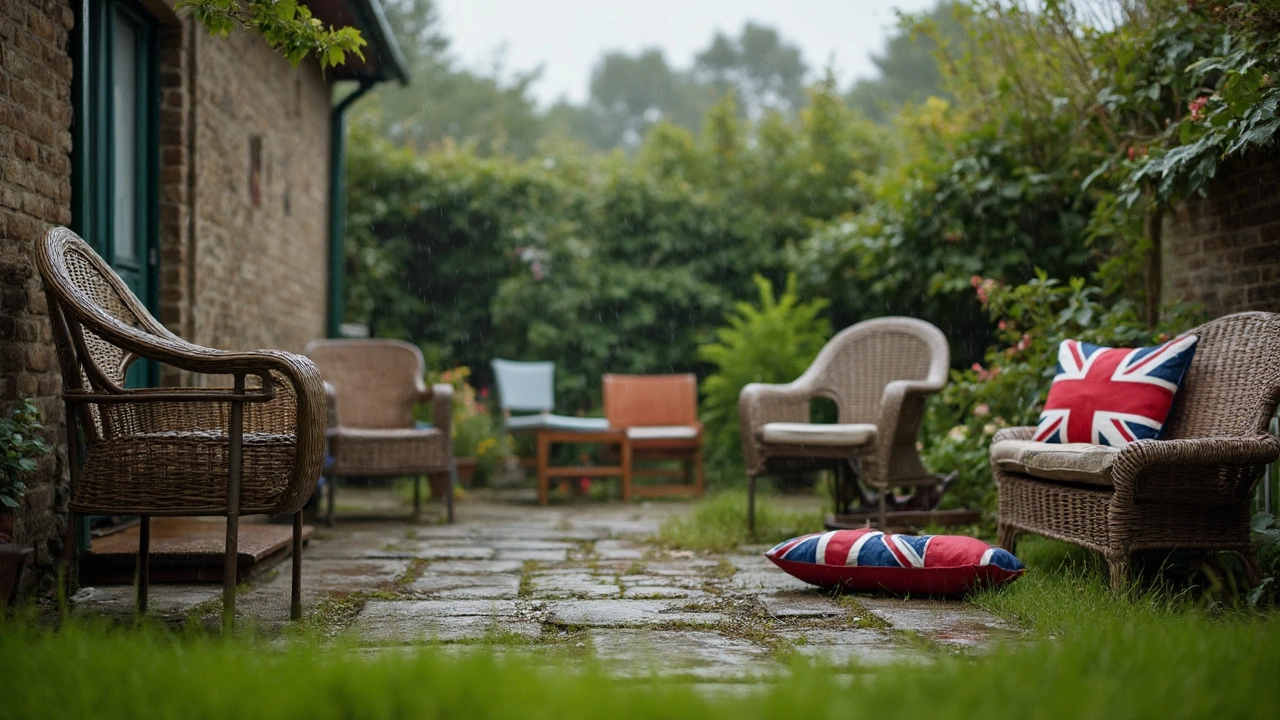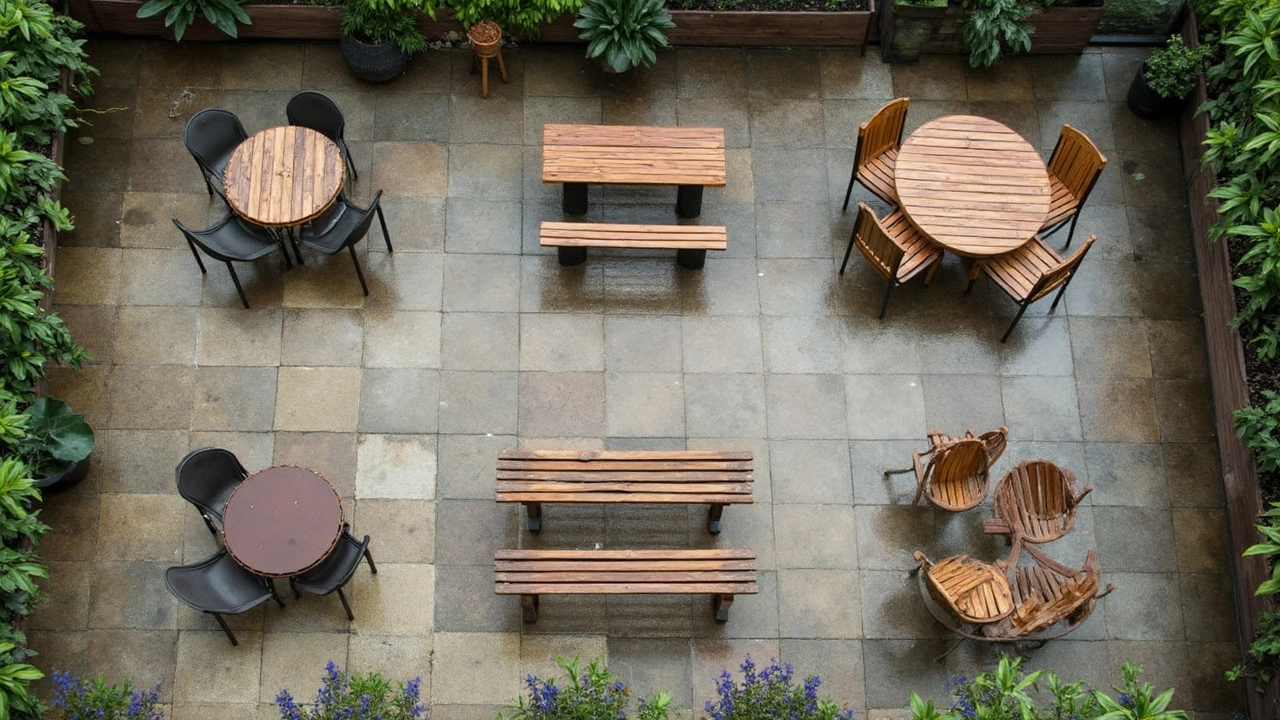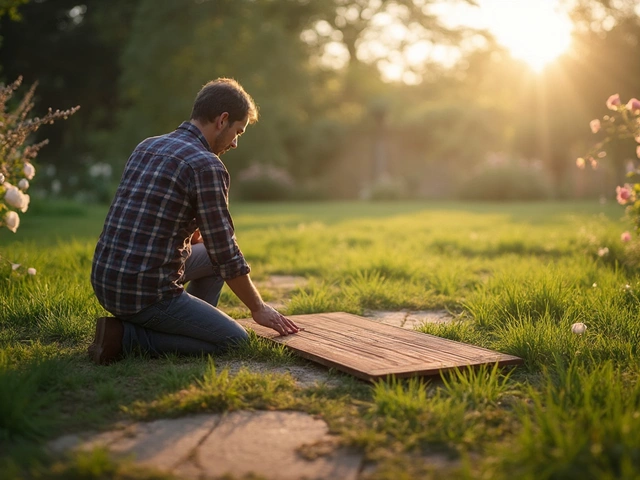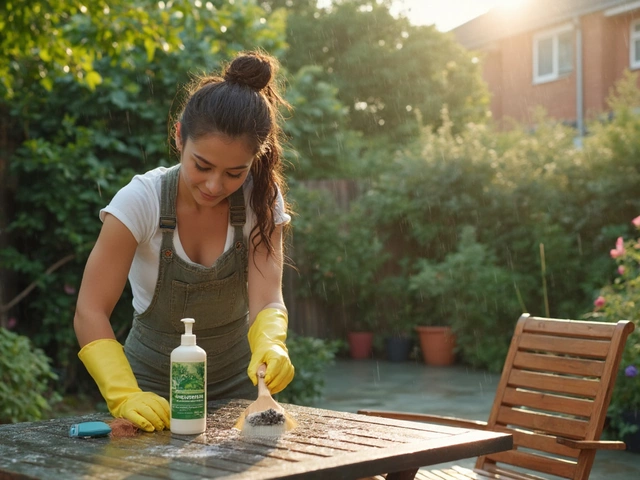 2
Jun,2025
2
Jun,2025
Ever hear that sound of sudden rain and instantly scramble to save your garden chairs? You’re not alone. Rain might seem harmless, but it can really mess with your outdoor furniture if you’re not prepared. Some pieces can take a beating, while others might not make it through a single soggy weekend.
Most people aren’t sure what’s actually happening to those tables and loungers when the clouds open up. Is the damage just about surface rust, or could it mess with the furniture’s insides, too? Spotting water damage isn’t always easy right away. Sometimes, you only realize something’s off when the chair wobbles or the cushions smell musty two days after the storm.
Knowing how your furniture reacts to rain can help you dodge headaches and save cash. Stick around—there are ways to fight back against the weather and keep your outdoor spot ready for friends, barbecues, or just lazy afternoons with your cat curled up next to you. The tips are simple, and you don’t need fancy gear or hours of your weekend to pull them off.
- Rain and Outdoor Furniture: What's at Stake?
- Different Materials, Different Problems
- Waterproof vs. Water-Resistant: The Real Difference
- What Rain Does Over Time
- Quick Tips to Rescue Wet Furniture
- How to Rain-Proof Your Outdoor Setup
Rain and Outdoor Furniture: What's at Stake?
When rain hits your backyard, it's not just the grass that soaks it up. Your garden furniture is right in the splash zone, and that brings a bunch of risks most people don’t think about until it’s too late. Water can wreck both how your furniture looks and how long it lasts, no matter how much you spent on that patio set.
Let’s get real: some outdoor tables and chairs are made to take a hit, but others crumble fast. All sorts of stuff can go wrong when your furniture sits out in wet weather. You might spot rust, see fabric turn moldy, or notice wood warping and splitting. Sometimes plastic gets brittle, too. The damage isn’t always obvious the next day; it can sneak up after a few seasons, making your furniture look tired or fall apart right when you want to enjoy it most.
Just check out what rain can do to different materials. Here’s a quick breakdown of common headaches that wet weather brings:
- Metal: Rust, corrosion, rough patches
- Wood: Warping, swelling, cracking, mold
- Plastic: Fading, brittleness, structural weakening
- Wicker and rattan: Mold, rot, unraveling
- Fabric cushions: Mold, mildew, bad odors
If you’re wondering why manufacturers brag about waterproof coatings or fancy materials, this is why. In a 2023 outdoor living survey, 68% of homeowners said they noticed some kind of water damage on their garden furniture after just one rainy season.
| Material | Typical Rain Damage | How Fast Damage Shows Up |
|---|---|---|
| Metal (iron/steel) | Rust, paint bubbling | 1-2 weeks after repeated rain |
| Wood | Warping, mold, split boards | 2-6 weeks depending on finish |
| Plastic | Fading, cracks | Several months of wet/dry cycles |
| Wicker/Rattan | Mold, rot | 1-3 weeks with no drying out |
| Outdoor Fabric | Mildew, odor | Days if left wet |
This kind of damage means more than just an ugly patio. If things get really bad, your furniture might not even be safe to use. So, before the next rainfall, it helps to know what’s at stake. But the good news? A little planning and a few small habits can save you a lot of trouble down the road.
Different Materials, Different Problems
Not all garden furniture reacts the same way to rain; the material type matters a lot. Some stuff shrugs off rain easily, while others can look rough after only a couple of storms.
Here’s a run-through of what actually happens to common materials:
- Wood: Most folks love wood furniture for its look, but water is its enemy. Untreated or old wood can warp, swell, or crack after soaking up too much water. Even treated wood isn’t totally immune—moisture can get in through scratches or worn finish, and mold loves to grow in the tiny grooves. Teak and eucalyptus handle water better than pine, but even the best natural wood will age faster outside unless you keep up with sealing it.
- Metal: When you think metal, rust probably comes to mind, and for good reason. Steel and iron furniture will start to rust if the paint or protective coating gets chipped. Aluminum doesn’t rust, but it can still get water spots and sometimes even corrode in salty air. Outdoor cushions left on metal frames can trap moisture and make rust happen faster.
- Plastic and Resin: These are usually the low-maintenance champs since most rain rolls right off. The real problem? Cheap plastic can get brittle and crack—especially if you leave it in the sun and rain back to back. Water can also collect inside hollow pieces, causing mildew or adding weight that bends the legs over time.
- Wicker (natural and synthetic): Real wicker doesn’t last long in wet weather. Rain seeps in and the material weakens or starts to rot. Even synthetic wicker (like resin) isn’t perfect. Water can pool under cushions, hiding mold and making the frame sag if you ignore it.
- Fabric and Cushions: Most garden furniture cushions aren’t made to be left in the rain, unless they’re labeled waterproof. Even “water-resistant” fabric only buys you a little time before the water gets in. After a few rain showers, cushions can get heavy, develop mold inside, or even start to smell. Quick-dry foam works way better, but it’s usually more expensive.
If you want your garden furniture to last, knowing what it’s made of is half the battle. The other half is catching problems early and not letting wet weather sneak up on you.
Waterproof vs. Water-Resistant: The Real Difference
Confused about whether your garden furniture is waterproof or just water-resistant? You’re not the only one. These words get thrown around on labels and ads like they mean the same thing, but there’s a big difference—especially when you’ve got dark clouds overhead.
Waterproof outdoor furniture is made to keep every drop out. That means even if your chair sits in a puddle, water won’t seep in. Usually, waterproof materials include things like treated metal, heavy-duty plastic, or specialty fabrics like marine-grade vinyl. These materials are often used on boat seats for a reason—they don’t soak up water, so they won’t start to rot, rust, or grow mold after a storm.
Water-resistant furniture, on the other hand, can handle some sprinkles or a quick shower. It’s treated to repel water, but if it gets drenched or sits in the rain for hours, water will eventually sneak through. Think of it like a rain jacket: good for a drizzle, but you wouldn’t stand in a downpour all day without getting soaked.
Here’s a quick way to spot the difference when you’re shopping or checking your current furniture:
- Check the tags: If it says waterproof, you’re good for heavy rain. Water-resistant means it needs extra care or covering in bad weather.
- Look at the material: Plastics and powder-coated metals are usually waterproof. Untreated wood, thin fabric, or regular steel is typically just water-resistant or not protected at all.
- Test it: Splash a little water on the surface. If the water beads up and rolls right off, you’ve likely got the waterproof stuff. If it soaks in or leaves a damp spot, that surface is only water-resistant.
If you want outdoor furniture that can stay out year-round, aim for waterproof first. Water-resistant pieces are great too, as long as you bring them in or use covers when the weather turns nasty. Skipping this step is how you end up with soggy cushions and rusty screws.

What Rain Does Over Time
It’s easy to shrug off a quick shower, but regular rain takes its toll on garden furniture in some sneaky ways. The first thing that happens? Water sneaks into cracks, seams, and joints. From there, it doesn’t just sit—it starts working against you, causing rust, rot, and mold. If you’ve ever wondered why your metal chair has started to stain your shorts or your wooden bench feels soft in random spots, rain is usually behind it.
Here’s how different materials react as rain keeps coming back for round after round:
- Wood: Absorbs water unless sealed well. Over time, this leads to warping, cracking, or even rotting. Some woods like teak are tougher, but untreated pine or oak? Not so much.
- Metal: Steel and iron get rusty pretty fast once paint chips or joints get exposed. Aluminum does better, but it can still corrode eventually if water pools on screws or bolts.
- Plastic and resin: These stand up better since they don’t rot or rust, but rain can make them brittle. If the water sits and algae forms, things get slippery and gross.
- Fabrics: Cushions and covers are moisture magnets. If they stay wet, mold and mildew show up fast, bringing smells and stains. Weatherproof fabrics slow it down, but even they give in after enough wet cycles.
Honestly, some of this stuff happens fast. According to a 2023 outdoor living survey, over 68% of people noticed visible damage like rust or faded fabric within six months of leaving their garden furniture uncovered in a rainy climate.
| Material | Typical Problem | Average Time Until Damage Shows* (months) |
|---|---|---|
| Untreated Wood | Warping/Rotting | 4-7 |
| Metal (Steel/Iron) | Rust | 3-6 |
| Aluminum | Corrosion (Bolts/Screws) | 9-14 |
| Plastic/Resin | Brittling/Algae | 10-15 |
| Outdoor Fabrics | Mold/Mildew/Smells | 2-5 |
*Based on real user reports in mild to heavy rainfall areas.
If you start seeing small spots on wood or fabric, or notice screws rusting, jump on it quick. Little things get big fast when rain keeps coming back. And trust me, nothing ruins a backyard hangout like the surprise of a collapsed chair or a funky-smelling cushion you forgot to bring in last weekend. Keeping an eye out can seriously stretch the life of your furniture—no magic or endless scrubbing required.
Quick Tips to Rescue Wet Furniture
So, your garden furniture just got caught in a downpour? Don’t freak out—there’s plenty you can do to keep it from getting ruined. Moving fast after the rain stops is key, especially for cushions and wood pieces. Here’s how you dodge mildew, rust, and all-out misery:
- Wipe It Down, Top to Bottom: Right after the rain, grab a clean towel and dry all surfaces. For cushions, press with the towel instead of rubbing. It helps soak up water without pushing it deeper in.
- Stand Cushions Upright: If your cushions have zippers, unzip them to give moisture an easy escape route. Place them against a wall, so air can get to both sides. They’ll dry way quicker this way.
- Remove Metal Parts, If Possible: If your furniture lets you take metal pieces off, do it and dry them separately. Pay extra attention to screws and joints—these spots love to hang on to water and start rusting.
- Use a Fan or Blow Dryer: Speed up the drying with a household fan. For small puddles on tricky surfaces, hit them with a blow dryer set to cool.
- Clean Before Mold Can Grow: Mix some mild soap with warm water and wipe surfaces. This helps remove any grime left by the rain that can lead to mold.
- Move Furniture Onto a Dry, Flat Surface: Don’t let furniture sit in puddles—it can soak up even more water, especially wood. Move things onto a grill rack, a plastic tarp, or anything raised and dry until the water’s out.
It’s not just about drying—the timing really matters. Research shows that mold can start growing on wet fabrics within 48 hours if things stay damp. Keeping air moving is your best weapon, so open up the cushions and let them breathe.
| Material | Visible Damage After | Typical Problem |
|---|---|---|
| Wood | 1-2 days | Warping, mildew |
| Fabric Cushions | 1-3 days | Mold, smells |
| Metal | 2-5 days | Rust |
| Plastic/Resin | Rarely | Staining |
If you catch rain damage fast, your furniture recovers better, looks fresher, and lasts longer. Even quick steps like shaking off the puddles and popping cushions in the sun make a huge difference. Don’t put cushions back on wet furniture—wait until every part is completely dry, or you’ll just trap moisture all over again.
How to Rain-Proof Your Outdoor Setup
No one wants to drag soggy cushions inside or scrub mildew for hours. Let’s make your setup ready for those downpours without tons of hassle. The goal: keep your garden furniture dry and looking good with as little effort as possible. Here’s how you can do it.
“Outdoor furniture isn’t just about weathering the elements; it’s about easy fixes and smart routines,” says Dan Murphy, Outdoor Living Specialist at Patio Experts Weekly. “The best defense is simple maintenance and solid covers.”
Here’s what really works for rain-proofing your space:
- Invest in covers: Look for water-resistant or waterproof covers that fit your pieces snugly. Covers with vents help stop moisture from building up underneath, so you don’t accidentally create a mold factory.
- Store cushions smartly: Cushions and soft pads soak up water fast. Grab a waterproof storage box or an outdoor storage bench. It’s way quicker than dragging everything inside every time the sky looks moody.
- Elevate wooden legs: Put rubber or plastic feet on wooden legs so they don’t sit right on wet ground. A few bucks on risers can keep rot away for years.
- Seal wood and metal: Apply a fresh layer of sealant or anti-rust spray once a year. This step is huge for wood, which swells and cracks when soaked, and for metal, which loves to rust at the smallest excuse.
- Pick the right spot: Leave your furniture under a sturdy awning, tree, or even a cheap tarp when you’re not using it for a while. Shade helps slow down sun and rain damage.
If you’re wondering about the facts, here’s some straight numbers based on a 2024 survey from the Homeowners’ Outdoor Guide:
| Rain-Proofing Method Used | Reported Furniture Damage (%) |
|---|---|
| No cover or protection | 75% |
| Cover only | 28% |
| Cover + storage + sealant | 11% |
Saves you money, saves you time, and saves you from having to spend a Saturday scrubbing mildew. Don’t forget—routine quick checks for loose screws, rust spots, and surface cracks stop small problems from turning into big disasters later on. It’s all about those low-effort habits that keep your outdoor space ready whenever you want to hang out—even if you’ve got a cat that claims every chair, like Tigger does at my place.




